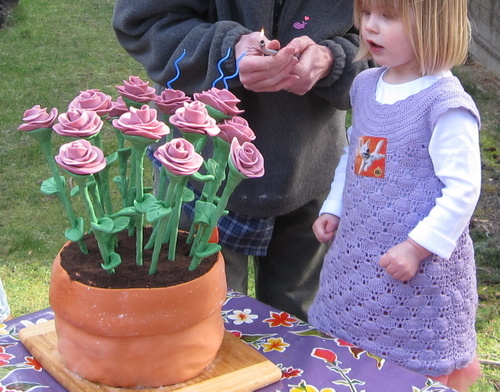 After Eliza, our first daughter, came into our lives, we sort of stopped throwing parties. Gone were the days of the Kung Fu Fondue Bash and Home Brew-Barbecue-Tattoo Night.
After Eliza, our first daughter, came into our lives, we sort of stopped throwing parties. Gone were the days of the Kung Fu Fondue Bash and Home Brew-Barbecue-Tattoo Night.
But we eventually discovered a new kind of party that meshed with our suddenly exhausting lifestyle. When Eliza turned one, we invited all of our friends, and hers, of course, to celebrate her birthday with us. By shifting our party hours earlier, we could have lunch instead of dinner and still squeeze in naps and a reasonable bedtime. Problem solved.
When Tessa’s first birthday rolled around, though, we had just moved from Santa Barbara, CA, to Friday Harbor, WA. As practically friendless newcomers, we decided to forgo the traditional birthday bash we’d come to know and love. My parents came from California, we went out to a nice dinner, ate some cake, and that was that.
By the time Tessa turned two, we’d connected with an amazing group of island friends, so we planned a big party for our small girl. But the night before the party, Tessa burned with high fever and grew delirious, so we cancelled the event at the last minute.
Long before her third birthday approached, Tessa declared that she wanted a garden party with a rose cake. We didn’t care about the fact that her birthday falls in February, and that for all we knew it might be snowing. My girl had waited three years for an honest-to-goodness party, and she was going to have one awesome party this year.
I’d been toying with the idea of using fondant to decorate a cake for some time. I’d started making fanciful cakes–a crab for Eliza’s birthday and a shark cake for a friend’s. They both looked fine, but I couldn’t get the butter cream smooth enough to make me happy. I knew fondant would solve the problem, but it just seemed so intimidating, and I always chickened out at the last minute. Over dinner one night, my friend Elizabeth convinced me that it was simple. “If I can do it,” she said, “so can you.” The recipe she sent me for marshmallow fondant looked easy enough, and I had this vision of a cake that I knew I couldn’t pull off with butter cream frosting. This was just the excuse I needed to give it a try.
I didn’t want to risk ruining Tessa’s party with a serious cake wreck, so I decided to make sure I could really create the cake that looked so lovely in my mind. The week before the party, I made marshmallow fondant for the first time. I mixed some pink icing color into a large slab of it and tried making roses. Through trial and error, I learned to make a small pink fondant egg and wrap circular petals around it. I didn’t have the gum paste I needed to help my blooms hold their shape, but letting them sit over night hardened up the petals a bit.
The green candy sticks I’d bought for stems seemed too short and squat to use. My husband suggested wrapping green fondant around long skewers; once wrapped, it was easy to stick the roses in the pointy ends, and then I could use extra green fondant to smooth the transition from flower to stem.
I started fastening leaves to the stems, and they stayed put for a while, but eventually they drooped or fell off the stems. Additional skewers topped with a cushioning of fondant or paper towel braced the leaves and gave them the boost they needed to harden and stay put. In the meantime, I tried to mix colors with another chunk of fondant to produce a hue that looked like terra cotta.
In the midst of our experiment, our neighbors invited us over for dinner, so we offered to bring dessert. I had baked two two-layer cakes, so we felt relieved to be able to share our four-layer prototype with friends. We frosted the cake, rolled out terra cotta fondant over a thick sprinkling of corn starch, and then wrapped the fondant around it the cake. After sprinkling smashed chocolate wafers on the top for dirt, we added the flowers. Our neighbors looked a little surprised when we arrived at their impromptu dinner party with our 12-pound cake.
The trial run helped me realize that I needed to get started on the flowers mid-week. Fortunately, the large piece of foam we found to hold our fondant-wrapped skewers made the task of moving them out of small fingers’ reach easy.
The day before the party, we prepped food and craft projects while spending time with visiting with family and friends. After baths and stories and tucking girls into bed, we finally got started decorating the cakes I’d baked earlier that day. It took some time to get the shade of terra cotta fondant just right, and then our first attempt to wrap the cake in it proved disastrous. I rolled the fondant too thin, and it started tearing on the cake. About this time I was wishing we had saved our prototype cake instead of eating it. After trying everything we could think of to make it look better, I ended up making another batch of fondant sometime around midnight. I rolled it thicker this time, and that prevented tearing.
The next next time I make a flower pot cake, I’ll roll out a giant circle and cover the cake from the top down instead of wrapping fondant around the sides. I have since decorated other cakes with fondant, and covering from the top down makes the process easy. Fondant stretches quite a bit during application, and applying from the top allows the downward stretching to work with you. Wrapping fondant around a cake combines downward stretching and sidewards stretching and finally leaves you with a long seam down the cake.
Late that night I also learned that you only need a very thin base-coat of frosting beneath fondant. Instead of the smooth, flat finish I’d hoped for, the thick layer of frosting I’d smoothed on the cake squished around underneath, making it buckle in some places. At this point in the evening, I wasn’t up to making yet another batch of fondant, but some day I’ll make a perfectly smooth flower pot cake. Once I came to terms with the uneven surface, I added a wide band of fondant around the top to make it look more like a real pot, and it was ready for cookie crumb dirt and fondant roses.
I used to be the kind of person who likes to stay up really late, but I’m not any more. I just start getting grumpy and clumsy late at night, so it’s better for everyone if I go to bed early. Decorating cakes has helped me rediscover my ability to function at night, though. This project kept me up until around 3:00 A.M., and, despite some tense moments, I didn’t get especially grumpy or clumsy. I even had fun. Thankfully, I have this awesome night owl husband; I’m pretty sure severe grumpiness and dangerous clumsiness would have reigned that night if I didn’t have him helping me figure out what to do along the way. And the fun? That wouldn’t have happened. Oh, and the cake for the poor three-year-old who’d never yet had a birthday party? That wouldn’t have happened either.
So, not too long after we finished the cake, we bundled up for for Tessa’s winter-style garden party. Outside on that brisk February day, we planted real bulbs in small pots. We tried not to shiver too much while making paper flower crafts. And after lunch, we had flower pot cake, and even a few magical wind-free moments that enabled Tessa to blow out her candles.
After that, kids ran around eating roses. They were pretty sugared up before they even got to the cake.
This year, Tessa wants a Tinkerbell cake. Check back with me in February to see if I can pull that one off.




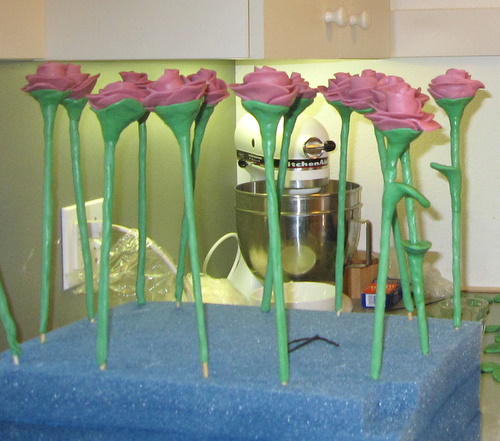
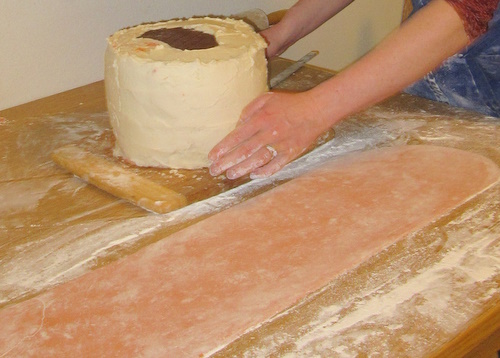
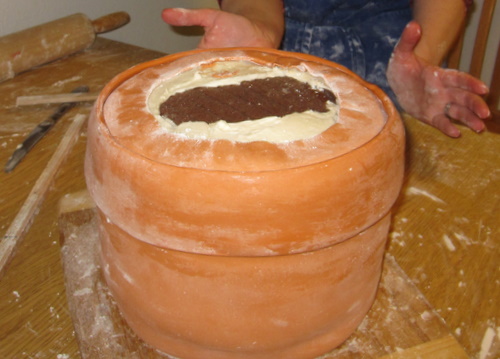
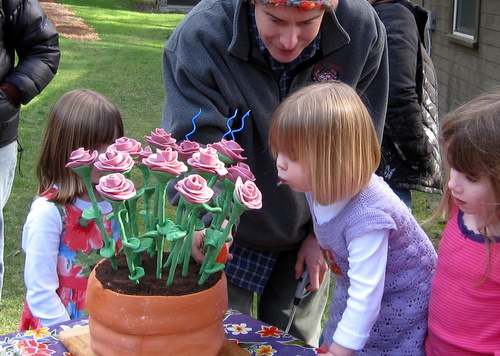
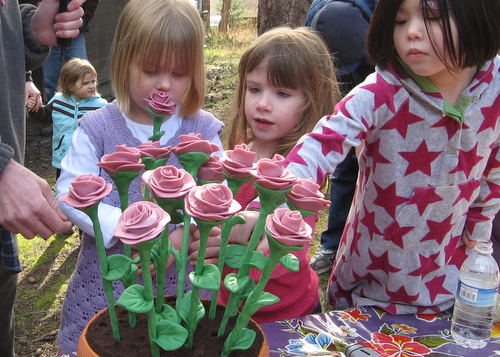
Thank you!!!! I’ve been looking all over the Web for tips on how to make a Venus Fly Trap cake, and though there are a few examples, there are no good step by step instructions, especially regarding how to get the flowers to stand up. Finally you’ve helped me see how it can be done! Thank you so much for taking the time to do the step-by-step instructions. Your rose cake is beautiful!!
What a cool idea, Vikky! I would love to see a picture of your Venus Fly Trap Cake! Glad you found some ideas here to help you!